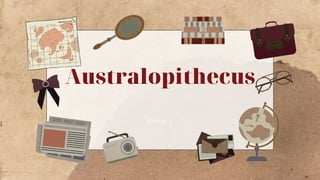Group 1 AP.pptx
he fossil record seems to indicate that Australopithecus is ancestral to Homo and modern humans.The study of human evolution is a fascinating journey through time, unveiling the complex and intricate process by which modern Homo sapiens emerged from their ancestral roots. Australopithecus, a genus of hominins that lived between 4.2 and 2 million years ago, occupies a crucial position in this narrative. In this essay, we will explore the significance of Australopithecus in the context of human evolution, focusing on their physical characteristics, behavioral adaptations, and their role as the bridge between apes and humans. I. Taxonomy and Classification Australopithecus, a word meaning "southern ape," is a genus within the family Hominidae, which also includes humans and their closest relatives. This genus includes several species, the most well-known being Australopithecus afarensis and Australopithecus africanus. These early hominins exhibited a blend of ape-like and human-like characteristics, making them central to the study of human evolution. II. Physical Characteristics A. Bipedalism One of the most distinguishing features of Australopithecus is their adaptation to bipedalism or walking on two legs. Their pelvis, femur, and foot bones show clear signs of modifications for upright walking. This transition from a quadrupedal to a bipedal locomotion marked a significant departure from their ape ancestors and laid the foundation for the human lineage. B. Dental Morphology Australopithecus exhibited a combination of ape-like and human-like dental features. They had relatively small canine teeth compared to apes but still retained larger molars adapted for processing plant material. This dental adaptation suggests a shift towards a more varied diet. C. Cranial Capacity The cranial capacity of Australopithecus was larger than that of non-human primates but significantly smaller than that of modern humans. This suggests a gradual increase in brain size during human evolution. III. Behavioral Adaptations A. Tool Use Australopithecus is associated with the earliest evidence of tool use, although their tools were quite simple compared to those used by later hominins. Stone tools found in association with Australopithecus fossils indicate the use of these tools for butchering meat and processing plant materials, marking an important step in the evolution of technology and dietary habits. B. Social Structure There is evidence to suggest that Australopithecus lived in social groups. The presence of fossils in close proximity to one another and evidence of cooperation in activities like food gathering and defense implies some form of social structure and communication. IV. Australopithecus as a Transitional Species Australopithecus is often referred to as a transitional species because of its intermediate characteristics. They represent a crucial link between the last common ancestor of humans and apes and the later Homo genus. The development

Recommended
Recommended
More Related Content
Similar to Group 1 AP.pptx
Similar to Group 1 AP.pptx (20)
Recently uploaded
Recently uploaded (20)
Group 1 AP.pptx
- 2. Anamencis Afarencis Africanus Australopithecus, (Latin: “southern ape”) (genus Australopithecus), group of extinct primates closely related to, if not actually ancestors of, modern human beings and known from a series of fossils found at numerous sites in eastern, north-central, and southern Africa. Australopithecus africanus is an extinct species of australopithecine which lived between about 3.3 and 2.1 million years ago in the Late Pliocene to Early Pleistocene of South Africa. The species has been recovered from Taung, Sterkfontein, Makapansgat, and Gladysvale. Australopithecus anamensis is a hominin species that lived approximately between 4.2 and 3.8 million years ago and is the oldest known Australopithecus species, living during the Plio-Pleistocene era. Australopithecu s
- 3. Australopithecus anamensis individuals had thickly-built, long, narrow jaws with their side rows of teeth arranged in parallel lines. Their strong jaws combined with heavily enameled teeth suggest Au Anamencis
- 4. afarensis had both ape and human characteristics: members of this species had apelike face proportions (a flat nose, a strongly projecting lower jaw) and braincase (with a small brain, usually less than 500 cubic centimeters -- about 1/3 the size of a modern human brain), and long, strong arms with curved fingers . Afarencis
- 5. afarensis had both ape and human characteristics: members of this species had apelike face proportions (a flat nose, a strongly projecting lower jaw) and braincase (with a small brain, usually less than 500 cubic centimeters -- about 1/3 the size of a modern human brain), and long, strong arms with curved fingers . Africanus
- 6. An am en cis • The first fossils of A. anamensis discovered, are dated to around 3.8 and 4.2 million years ago and were found in Kanapoi and Allia Bay in Northern Kenya. It is usually accepted that A. afarensis emerged within this lineage. • Meave Leakey and Alan Walker) are credited with the discovery of Au. anamensis material.
- 7. Af ar en cis A new species name, Australopithecus afarensis, was therefore created for them in 1978. This species is now represented by several hundred fossils from east Africa. 'Lucy' AL 288-1 – a partial skeleton discovered in 1974 by Donald Johanson in Hadar, Ethiopia.
- 8. Af ric an us Raymond Dart described it and named the species Australopithecus africanus (meaning southern ape of Africa), it took more than 20 years for the scientific community to widely accept Australopithecus as a member of the human family tree.
- 9. Thank you!